| 1 August |
• yesterday • tomorrow |
| Memorial of Saint Alphonsus Liguori, Bishop and Doctor of the Church |
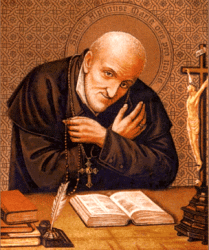
Alfonso, Alfons, Alfontso, Alphonse, Alfonsu, Afonso
Born to the nobility, Alphonsus was a child prodigy; he became extremely well-educated, and received his doctorate in law from the University of Naples at age 16. He had his own legal practice by age 21, and was soon one of the leading lawyers in Naples, though he never attended court without having attended Mass first. He loved music, could play the harpsichord, and often attended the opera, though he frequently listened without bothering to watch the over-done staging. As he matured and learned more and more of the world, he liked it less and less, and finally felt a call to religious life. He declined an arranged marriage, studied theology, and was ordained at age 29.
Preacher and home missioner around Naples. Noted for his simple, clear, direct style of preaching, and his gentle, understanding way in the confessional. Writer on asceticism, theology, and history; master theologian. He was often opposed by Church officials for a perceived laxity toward sinners, and by government officials who opposed anything religious. Founded the Redemptoristines women's order in Scala in 1730. Founded the Congregation of the Most Holy Redeemer (Liguorians; Redemptorists) at Scala, Italy in 1732.
Appointed bishop of the diocese of Sant'Agata de' Goti, Italy by Pope Clement XIII in 1762. Worked to reform the clergy and revitalize the faithful in a diocese with a bad reputation. He was afflicted with severe rheumatism, and often could barely move or raise his chin from his chest. In 1775 he resigned his see due to ill health, and went into what he thought would be a prayerful retirement.
In 1777 the royal government threatened to disband his Redemptorists, claiming that they were covertly carrying on the work of the Jesuits, who had been suppressed in 1773. Calling on his knowledge of the Congregation, his background in thelogy, and his skills as a lawyer, Alphonsus defended the Redemptorists so well that they obtained the king's approval. However, by this point Alphonsus was nearly blind, and was tricked into giving his approval to a revised Rule for the Congregation, one that suited the king and the anti-clerical government. When Pope Pius VI saw the changes, he condemned it, and removed Alphonsus from his position as leader of the Order. This caused Alphonsus a crisis in confidence and faith that took years to overcome. However, by the time of his death he had returned to faith and peace.
Alphonsus vowed early to never to waste a moment of his life, and he lived that way for over 90 years. Declared a Doctor of the Church by Pope Pius IX in 1871.
When he was bishop, one of Alphonsus's priests led a worldly life, and resisted all attempts to change. He was summoned to Alphonsus, and at the entrance to the bishop's study he found a large crucifix laid on the threshold. When the priest hesitated to step in, Alphonsus quietly said, "Come along, and be sure to trample it underfoot. It would not be the first time you have placed Our Lord beneath your feet."
27 September 1696 at Marianelli near Naples, Italy
1 August 1787 at Nocera, Italy of natural causes
26 May 1839 by Pope Gregory XVI
• against arthritis
• against scrupulosity
• confessors (given on 26 February 1950 by Pope Pius XII)
• final perseverance
• moral theologians
• moralists (1950 by Pope Pius XII)
• scrupulous people
• theologians
• vocations
• Sisters of the Holy Redeemer
• diocese of Acerra, Italy, diocese of
• Agrigento, Italy
• Pagani, Italy
• Sant'Agata de' Goti, Italy
• chaplet
• praying with a monstrance in his hands
• pen
• quill
• crucifix
• writing
• bishop with his chin on his chest
• YouTube PlayList
• The Glories of Mary (audio book)
We must show charity towards the sick, who are in greater need of help. Let us take them some small gift if they are poor, or, at least, let us go and wait on them and comfort them. - Saint Alphonsus Liguori
If we should be saved and become saints, we ought always to stand at the gates of the Divine mercy to beg and pray for, as an alms, all that we need. - Saint Alphonsus Liguori
He who does not acquire the love of God will scarcely persevere in the grace of God, for it is very difficult to renounce sin merely through fear of chastisement. - Saint Alphonsus Liguori
When we hear people talk of riches, honors and amusements of the world, let us remember that all things have an end, and let us then say: "My God, I wish for You alone and nothing more." - Saint Alphonsus Liguori
He who trusts himself is lost. He who trusts in God can do all things. - Saint Alphonsus Liguori
He who communicates most frequently will be freest from sin, and will make farthest progress in Divine Love. - Saint Alphonsus Liguori
I love you, Jesus my love, I love you more than myself. I repent with my whole heart for having offended you. Never permit me to separate myself from you again. May I love you always, and then do with me as you will. - Saint Alphonsus Liguori
https://catholicsaints.info/saint-alphonsus-maria-de-liguori/
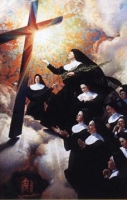
• Martyrs of Novogrudok
• Nasaret-sostrene fra Nowogródek
• Nowogrodek Martyrs
• Sister Mary Stella and her Ten Companions
• Sisters of the Holy Family of Nazareth
A group of eleven Holy Family of Nazareth nuns who were murdered by the Nazi Gestapo in exchange for 120 condemned citizens of Nowogrodek, Belarus who were scheduled for revenge killings. They are –
• Adela Mardosewicz
• Anna Kukolowicz
• Eleonora Aniela Józwik
• Eugenia Mackiewicz
• Helena Cierpka
• Jadwiga Karolina Zak
• Józefa Chrobot
• Julia Rapiej
• Leokadia Matuszewska
• Paulina Borowik
• Weronika Narmontowicz
• machine-gunned by firing squad on 1 August 1943 by the Gestapo about three miles outside Novogrudok (Nowogródek), Hrodzyenskaya voblasts', in Nazi occupied Belarus
• buried on the site of the execution in a common grave
• one of their surviving sisters, Maria Malgorzata Banas, located the grave on 19 March 1945 and tended to it until her death in 1966
• relics re-interred in a common sarcophagus in the chapel of the Novograd Farny Church (the Church of the Transfiguration, also known as Biala Fara or the White Church)
5 March 2000 by Pope John Paul II in Rome, Italy
I cordially greet the pilgrims from Poland and Belarus. I extend a particular greeting to the Sisters of the Congregation of the Holy Family of Nazareth, who have come here to thank God for the gift of the beatification of their 11 sisters, the martyrs of Nowogródek. In commemorating these heroic Nazareth Sisters, Jesus' words come to mind: "There is no greater love than this: to lay down one's life for one's friends" (cf. John 15:13). They perfectly confirmed the truth of these words by their lives filled with devotion and by their death. Before the war and during the occupation, they zealously served the inhabitants of Nowogródek, participating actively in pastoral care and education and engaging in various works of charity. Their love for those among whom they fulfilled their mission took on special significance during the horror of the Nazi invasion. Together and unanimously they offered their lives to God, asking in exchange that the lives of the mothers and fathers of families and that of the local pastor be spared. The Lord graciously accepted their sacrifice and, we believe, abundantly rewarded them in his glory. Today, together with the entire Congregation of Nazareth Sisters, let us praise God for this grace, through which the religious charism and human zeal were able to yield such marvellous fruits of martyrdom. May the blood of these blessed sisters be the seed of new religious vocations and a support for many on the ways of holiness. May the new blesseds, Maria Stella Mardosewicz and her 10 sisters, intercede with God for all the people of Belarus, whom I cordially greet. – Pope Saint John Paul II, greeting the pilgrims on 6 March 2000 who had come to Rome for the beatification recognition of the Martyrs of Nowogródek
God was also a true "protector and helper" for the martyrs of Nowogródek – for Blessed Maria Stella Mardosewicz and her 10 sisters, professed religious of the Congregation of the Holy Family of Nazareth. For them he was a helper throughout their lives and at the moment of their terrible test, when for an entire night they awaited death; he was a helper especially on the way to the place of execution, and finally at the moment they were shot. Where did these women find the strength to give themselves in exchange for the lives of imprisoned residents of Nowogródek? From where did they draw the courage to accept calmly the death sentence that was so cruel and unjust? God had slowly prepared them for this moment of greater trial. He sowed the seed of his grace in their hearts at the time of holy Baptism and then, tended with great care and responsibility, it developed firm roots and bore the most beautiful fruit, which is the gift of life. Christ says: "There is no greater love than this: to lay down one's life for one's friends" (John 15:13). Yes, there is no greater love than this: to be ready to lay down one's life for one's brothers and sisters. We thank you, O blessed martyrs of Nowogródek, for your witness of love, for your example of Christian heroism and for your trust in the power of the Holy Spirit. "Christ chose and appointed you that you should go and bear fruit in your lives and that your fruit should abide" (see John 15:16). You are the greatest inheritance of the Congregation of the Holy Family of Nazareth. You are the inheritance of the whole Church of Christ for ever! – homily of Pope Saint John Paul II during the beatification recognition Mass of the Martyrs of Nowogródek
https://catholicsaints.info/martyrs-of-nowogrodek/
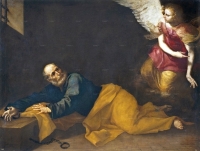
• Saint Peter ad Vincula
• San Pietro in Vincoli
• Liberation of Saint Peter
• Release of Saint Peter
• Deliverance of Saint Peter
The feast was originally kept in Rome, Italy to commemorate the dedication of the Church of Saint Peter on the Esquiline Hill built by Eudoxia Licinia in 442, and rebuilt by Adrian I in the 8th century. When the chains which Saint Peter had worn in prison, and from which he was freed by angelic intervention (see readings below) were later venerated there, the feast received its present name.
The date when these chains were brought from Jerusalem is disputed; some claim they were brought in 116 by travellers sent in search of them by Saint Balbina and her father Saint Quirinus, while others think Saint Eudoxia brought them in 439. Pope Saint Leo the Great united them to the chains with which Saint Peter had been fettered in the Mamertine Prison, forming a chain about two yards long which is preserved in a bronze safe and guarded by a special confraternity.
• diocese of Annecy, France
• Donnas, Italy
About that time King Herod laid hands upon some members of the church to harm them. He had James, the brother of John, killed by the sword, and when he saw that this was pleasing to the Jews he proceeded to arrest Peter also. (It was [the] feast of Unleavened Bread.) He had him taken into custody and put in prison under the guard of four squads of four soldiers each. He intended to bring him before the people after Passover.
Peter thus was being kept in prison, but prayer by the church was fervently being made to God on his behalf. On the very night before Herod was to bring him to trial, Peter, secured by double chains, was sleeping between two soldiers, while outside the door guards kept watch on the prison. Suddenly the angel of the Lord stood by him and a light shone in the cell. He tapped Peter on the side and awakened him, saying, "Get up quickly." The chains fell from his wrists.
The angel said to him, "Put on your belt and your sandals." He did so. Then he said to him, "Put on your cloak and follow me." So he followed him out, not realizing that what was happening through the angel was real; he thought he was seeing a vision. They passed the first guard, then the second, and came to the iron gate leading out to the city, which opened for them by itself. They emerged and made their way down an alley, and suddenly the angel left him.
Then Peter recovered his senses and said, "Now I know for certain that [the] Lord sent his angel and rescued me from the hand of Herod and from all that the Jewish people had been expecting." When he realized this, he went to the house of Mary, the mother of John who is called Mark, where there were many people gathered in prayer. When he knocked on the gateway door, a maid named Rhoda came to answer it. She was so overjoyed when she recognized Peter's voice that, instead of opening the gate, she ran in and announced that Peter was standing at the gate.
They told her, "You are out of your mind," but she insisted that it was so. But they kept saying, "It is his angel." But Peter continued to knock, and when they opened it, they saw him and were astounded.
He motioned to them with his hand to be quiet and explained [to them] how the Lord had led him out of the prison, and said, "Report this to James and the brothers." Then he left and went to another place. At daybreak there was no small commotion among the soldiers over what had become of Peter. Herod, after instituting a search but not finding him, ordered the guards tried and executed. Then he left Judea to spend some time in Caesarea. - Acts 12:1-19
O God, who did loose from his chains thy blessed Apostle Saint Peter, and madest him to go forth of his prison without hurt: we beseech thee to loose us from the chains of our sins, and of thy mercy to ward off from us all manner of evil. - Sarum Missal
https://catholicsaints.info/feast-of-saint-peter-in-chains/
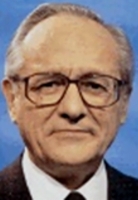
the bishop of the Muslims (he was called this by Muslim mourners at his funeral)
Born to a working class French family living in Algeria. At age 10, Pierre joined the scouts in a troop led by Dominicans, and became familiar with their spirituality. He attended college in Grenoble, France, and joined the Dominicans himself at the convent in Lille, France on 7 December 1958. He studied at a Dominican institute near Paris, France, and in 1962, after the Algerian war of independence, he returned to Algiers. There he served his mandatory time in the armed forces, but refused to bear arms. After his service, Pierre resumed his studies in France in September 1963, and was ordained a priest on 4 July 1965.
Father Pierre spent time learning Arabic and studying Islam, then returned to Algeria to help the people re-build their lives after the war. From 1973 to 1981 he ran an institute in Algiers for the study of classical Arabic and Islamic history; it was started as a way to prepare Christian missionaries for work in Islamic regions, but became a popular school for local Muslims who wanted to learn Arabic and their Islamic cultural history. Father Pierre worked for dialogue between Christians and Muslims, believing that communication and open religious discussion could lead to peace.
He was chosen bishop of Oran, Algeria on 25 May 1981. He built libraries, therapy centers for the handicapped, and schools, including ones for women. When the Algerian Civil War broke out in 1992, many of the Catholic clergy fled the country, but Father Pierre considered himself an Algerian as well as French, and stayed to work for peace and serve his flock. He died with his driver and friend Mohamed Bouchikhi in a bomb blast set by anti–Christian forces. Martyr.
8 May 1938 in Algiers, Algeria
• from a bomb explosion that destroyed the entrance to the chancery as he was entering the building on 1 August 1996 in Oran, Algeria
• seven people were convicted of the murders and sentenced to death on 23 March 1998; the Catholic Church of Algeria managed to get their sentences commuted
26 January 2018 by Pope Francis (decree of martyrdom)
https://catholicsaints.info/blessed-pierre-lucien-claverie/

The Machabees
Jewish dynasty which began with the rebellion of Mathathias and his five sons against the Syrian king, Antiochus IV (168 BC) and ruled the fortunes of Israel until the advent of Herod the Great. Syrian attempts to force Greek paganism on the Jews, the profanation of the Temple at Jerusalem, and the massacre which followed, brought the nation to arms under Mathathias, a priest of the sons of Joarib. At the death of Mathathias, Judas Machabeus, his third son, drove the Syrians and Hellenists out of Jerusalem, rededicated the Temple, and began an offensive and defensive alliance with the Romans. Before the treaty was concluded, however, Judas, with 800 men, risked battle at Laisa with an overwhelming army of Syrians under Bacchides, and was slain. He was succeeded in command by his youngest brother, Jonathan (161 BC). Jonathan defeated Bacchides, revenged the death of his brother, and made peace with Alexander who had usurped the throne of Demetrius, the successor to Antiochus. A period of peace followed in which Jonathan ruled as high priest in Jerusalem, but Tryphon, who was plotting for the throne of Asia, treacherously captured him at ptolemais and later put him to death. The captaincy of the armies of Israel then fell to Simon, the second son of Mathathias. Under him the land of Juda flourished exceedingly. He obtained the complete independence of the country and a grateful people bestowed upon him the hereditary kingship of the nation. His rule marked five years of uninterrupted peace. He was treacherously slain by his son-in-law, Ptolemy, about the year 135 BC After Simon the race of the Machabees quickly degenerated. In 63 BC the Romans thought it necessary to interfere in the fratricidal war between Hyrcanus II and Aristobulus II. With this interference and the advent of Herod the Great the scepter passed forever from the land of Juda. The story of the Machabees is written in the two books of the Old Testament which bear that name.
https://catholicsaints.info/holy-maccabees/
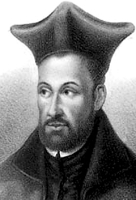
• Peter Favre
• Peter Lefrevre
• Petrus, Pierre
• Apostle of Germany
Born to a farm family, he was a shepherd in his youth. Taught catechism to other children. Entered Saint-Barbe College, Paris, France in 1525. Friend of Saint Francis Xavier and Saint Ignatius Loyola. Ordained in 1534. Joined Ignatius' early band of Jesuits on 15 August 1534. Assisted at the Diet of Worms in 1540. Assisted at the Diet of Ratisbon in 1541. Preached in Parma, Speyer, Mainz, Cologne, Savoy, Portugal, Lisbon and Valladolid, revitalizing the laity, reforming the clergy and opposing Lutheranism. Helped Saint Peter Canisius realize his vocation. Worked with Saint Francis Borgia. The pope planned to send him to the Council of Trent as theologian of the Holy See, and Pope John III wanted him to be the Patriarch of Ethiopia, but his health failed and he could not take either of these responsibilities. Had a great devotion to the angels. The diary of his travels and work has survived.
13 April 1506 at Villaret, Savoy
1 August 1546 at Rome, Italy of natural causes
17 December 2013 by Pope Francis
https://catholicsaints.info/saint-peter-faber/
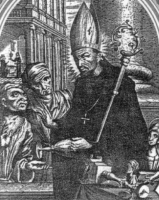
• Adeluoldus, Aethelwald, Aethelwold, Etelvoldo, Etelwold, Ethelwald
• Father of Monks
He grew up in the court of King Athelstan. Studied under and was ordained by his relative, Saint Alphege of Winchester. Ordained with Saint Dunstan of Canterbury. Benedictine dean at Glastonbury Abbey after Dunstan restored the Rule. Abbot of Abingdon, England in 954. Bishop of Winchester, England on 29 November 963. Built abbeys in his diocese, restored the monasteries of Newminster, Milton Abbas, Chertsey, Peterborough, Thorney and Ely, enforced discipline, and was one of the leaders of the 10th century monastic revival. Scholar, teacher, prelate, and royal counsellor. Supported the liturgical arts including music and manuscript illumination. Wrote Regularis Concordia, a monastic decree based on the Benedictine Rule.
c.912 at Winchester, England
• 1 August 984 of natural causes
• buried at cathedral of Winchester, England
https://catholicsaints.info/saint-ethelwold/
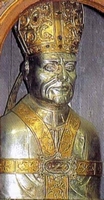
Émeric, Emerico
Born to the Italian nobility, the son of James II, lord of the region of Quart, Italy; two of his brothers also had lives in religion. Emericus studied theology in his youth, and earned a doctorate. He then lived as a hermit, dedicated to prayer and contemplation in an area now known as Valsainte, and which became the site of a oratory and pilgrimages. Cathedral canon at Sant’Orso in the late 13th century. Bishop of Aosta, Italy in 1301. He was noted for his austere life and his zeal for the salvation of souls.
mid 13th century in the castle of Quart, Italy
• 1 September 1313 of natural causes
• buried in the cathedral of Aosta, Italy
• relics exhumed and enshrined in 1515
14 July 1881 by Pope Leo XIII (cultus confirmation)
https://catholicsaints.info/blessed-emericus-of-quart/
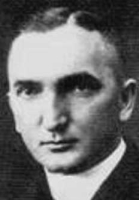
After graduating high school in Ostrów, Poland, he studied in Freising, Germany, Poznan, Poland, and Gniezno, Poland, Aleksy was ordained a priest in 1919. He served as parish priest and sometimes teacher in the Polish cities of Wagrowiec, Slupy, Trzemeszno, Siedlemin, and Gniezno. Prefect of a teacher's college for nine years. For being Polish and a priest, he was arrested by Nazis on 6 October 1941 and imprisoned in the Dachau concentration camp where he ministered to other prisoners until his death several months later. One of the 108 Polish Martyrs of World War II.
17 August 1895 in Przygodzice, Wielkopolskie, Poland
1 August 1942 at the concentration camp at Dachau, Oberbayern, Germany
13 June 1999 by Pope John Paul II at Warsaw, Poland
https://catholicsaints.info/blessed-aleksy-sobaszek/
Aled, Electa, Eled, Elevetha, Elined, Ellyw, Filuned, Luned, Lynette
A princess, the daughter of King Brychan. A pious girl, she made a private vow of chastity, and dedicated her life to Jesus. When her family tried to force her into an arranged marriage for political reasons, she fled her father's kingdom. Fearing Brychan's revenge if they helped her, villages turned her away. At Brecon she acquired a small hut, and lived there briefly as a prayerful hermitess. However, Brychan found her and demanded that she return home to be married. When she refused, standing by her vows, he killed her. Legend says that a healing spring of water appeared at the site of her death, and that the villages that had turned her away were beset with disasters. She is the Luned of the Mabinogion and the Lynette of Tennyson's Gareth and Lynette.
Welsh
beheaded in the 6th century by her father at Brecon, Wales
https://catholicsaints.info/saint-almedha/
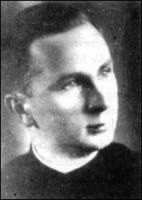
Priest in the archdiocese of Münster, Germany, ordained in 1932. Member of the Schoenstatt Movement. For preaching against Nazism, he was arrested by the Gestapo and shipped to the Dachau concentration camp on 15 December 1941. Martyred by the Nazis.
17 February 1907 in Klodzko, Dolnoslaskie, Germany (in modern Poland)
1 August 1942 in the Dachau concentration camp, Oberbayern, Bavaria, Germany of pneumonia and starvation
• 19 September 2010 by Pope Benedict XVI
• beatification recognition celebrated at the cathedral of Münster, Germany, Cardinal Joaquim Meisner, Archbishop of Cologne, Germany presiding
https://catholicsaints.info/blessed-gerhard-hirschfelder/
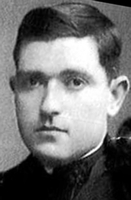
The son of a merchant, Vincente was baptized at the age of 4 days. He entered a minor seminary at age 10, and studied at the San Indalecio seminary. Ordained as a priest in the diocese of Almería, Spain on 2 June 1928. Martyred in the Spanish Civil War.
6 January 1904 in Lorca, Murcia Spain
shot ten times and stabbed on 1 August 1936 next to the walls of the cemetery in La Almolda, Zaragoza Spain
• 25 March 2017 by Pope Francis
• beatification celebrated in the Palacio de Exposiciones y Congresos de Aguadulce, Almería, Spain, presided by Cardinal Angelo Amato
https://catholicsaints.info/blessed-vicente-montserrat-millan/
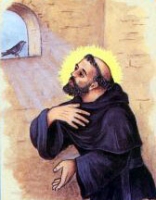
• Giovanni Bufalari
• John...
Brother of Blessed Lucy Bufalari. Augustinian friar-hermit at Rieti, Italy. Loved to serve at Mass. Friary porter, caring for travellers and the poor.
at Castel Porziano near Rome, Italy as Giovanni Bufalari
• c.1350 of natural causes
• miraculous healings reports at his tomb
1832 by Pope Gregory XVI (cultus confirmed)
https://catholicsaints.info/blessed-giovanni-bufalari/
Bernard Due Van Vo
24 November as one of the Martyrs of Vietnam
Adult convert to Catholicism. Priest in the apostolic vicariate of East Tonkin. Worked for decades at various missions around the country. Arrested in 1838 for the crime of priesthood. One of the Martyrs of Vietnam.
1755 in Quan Anh, Nam Dinh, Vietnam
beheaded on 1 August 1838 in Ba Tòa, Nam Dinh, Vietnam
19 June 1988 by Pope John Paul II
https://catholicsaints.info/saint-benado-vo-van-due/
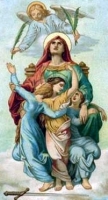
The daughters of Saint Sophia. While still children, they were tortured and martyred for their faith in the persecutions of Hadrian.
scourged, thrown into a fire, and then beheaded
https://catholicsaints.info/saint-charity/
https://catholicsaints.info/saint-faith/
https://catholicsaints.info/saint-hope/
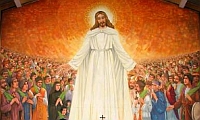
Dominic, Domenico
24 November as one of the Martyrs of Vietnam
Dominican priest. One of the Martyrs of Vietnam.
1772 in Nang A, Nghe An, Vietnam
beheaded on 1 August 1838 in Ba Tòa, Nam Dinh, Vietnam
19 June 1988 by Pope John Paul II
https://catholicsaints.info/saint-daminh-nguyen-van-hanh/
20 May (Benedictines)
Lay-brother in the Vallombrosan Order. Noted exorcist.
• 1242 of natural causes
• buried in a church yard next to the bell tower of Vallombrosa
• relics exposed in May 1600 along with several other Vallombrosans
• relics enshrined in a chapel for them in 1604
21 August 1600 by Bishop Alessandro de Medici (cultus approved)
https://catholicsaints.info/blessed-orlando-of-vallombrosa/
Arcadio, Arcade
Born to the Gallo-Roman aristocracy, the son of Count Apollinaire. Senator in the court of the Visigothic king Alaric II. Thrown from power due to political conflicts, he relocated to Bourges, France where he served as bishop in the mid 6th century. Attended the Council of Orléans in 538.
latter 5th century Clermont (in modern France)
• c.549 of natural causes
• relics at Saint Ursin, France
https://catholicsaints.info/saint-arcadius/
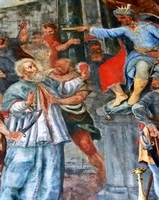
Procopio di Taormina
Bishop of Taormina, Sicily, Italy. Murdered along with hundreds of other Christians by invading Muslim Berbers. Martyr.
9th century
heart torn from his chest on 1 August 906 in Sicily, Italy by Hibraìm, leader of the invading Berbers
https://catholicsaints.info/saint-procopius-of-taormina/

Sofia
Legendary mother of the virgin martyrs Faith, Hope, and Charity. Three days after the death of the daughters, Sophia passed peacefully away while praying by their tomb. As her name means wisdom, and her offspring are named for virtues, some writers believer she is a personification of an allegory.
early 2nd century
https://catholicsaints.info/saint-sophia/

Friardo
Hermit on the island of Vindomitte, France. Friend of Saint Secundel. When tormented for his piety, a cloud of wasps attacked his tormenters; when Friard prayed for them, the wasps left.
511 at Bresne, France
577 of natural causes
against fear of wasps
https://catholicsaints.info/saint-friard/
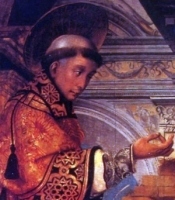
Feliu, Felice
Missionary. Martyred in the persecutions of Maximian Herculeus and Prefect Dacianus. The Christian poet Prudentius wrote in his honour.
Spanish
cut to pieces with knives in 303 in Gerona, Spain
https://catholicsaints.info/saint-felix-of-gerona-1-august/
Lifelong layman in the apostolic vicariate of England. School teacher. Martyred in the persecutions of King James I for the crime of being vocally Catholic.
Hutton Bushel, North Yorkshire, England
hanged on 1 August 1605 in York, North Yorkshire, England
15 December 1929 by Pope Pius XI
https://catholicsaints.info/blessed-thomas-welbourne/
Pellegrino
Celtic monk. Pilgrim to the Holy Lands. On his return, he spent the rest of his life as a hermit in the Apennines near Modena, Italy where he was known by the locals for his sanctity.
643 of natural causes
Casola in Lunigiana, Italy
https://catholicsaints.info/saint-peregrinus-of-modena/
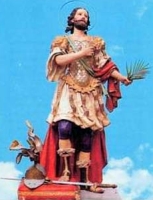
Bonus
Priest. Martyred with eleven others. The town of San Buono, Italy is named for him.
• c.259 on the Latin Way, Rome, Italy
• buried in the cemtery fo San Priscilla
San Buono, Italy
https://catholicsaints.info/saint-buono/
An indulgence which may be gained in any church so designated by the bishop, by all the faithful who after Confession and Holy Communion, visit such churches between noon of 1 August and midnight of 2 August, or on the Sunday following. The indulgence is toties quoties and is applicable to the souls in Purgatory.
https://catholicsaints.info/portiuncula-indulgence/
Secondino
3 August (diocese of Palestrina, Italy)
Bishop of Palestrina, Italy. Martyred in the persecutions of Diocletian.
315 on the Via Prenestina, 13 miles from Rome, Italy
https://catholicsaints.info/saint-secundus-of-palestrina/
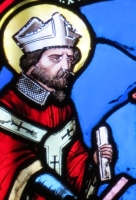
Exsuperije, Exupere, Soupierre, Soupir, Soupire, Spire, Spirius
Fourth century bishop of Bayeux, France.
https://catholicsaints.info/saint-exuperius-of-bayeux/
Athius, Attus
Martyred with several companions by order of Flavian for destroying the altar of a pagan goddess during the persecutions of Diocletian.
beheaded c.300 at Perga, Pamphylia
https://catholicsaints.info/saint-attius-of-perga/
Martyred during the persecutions of Diocletian with several companions by order of Flavian for destroying the altar of a pagan goddess.
beheaded c.300 at Perga, Pamphylia
https://catholicsaints.info/saint-alexander-of-perga/
Martyred with several companions by order of Flavian for destroying the altar of a pagan goddess during the persecutions of Diocletian.
beheaded c.300 at Perga, Pamphylia
https://catholicsaints.info/saint-leontius-of-perga/
Vallombrosan monk. Spiritual student of Saint John Gualbert. Abbot general.
1076 of natural causes
1600 by Bishop Alessandro de Medici of Fiesole (cultus confirmed)
https://catholicsaints.info/blessed-rudolph/
Nephew of Saint Patrick who consecrated him as a travelling, missionary bishop. Worn from his travels, he retired to live as a monk and then abbot of the monastery Inishboffin, Ireland.
c.480
https://catholicsaints.info/saint-rioch/
Kined of Wales
Son of a 6th century chieftain. Hermit on the peninsula of Gower, Wales, a place later known as Llangenydd in his honour.
https://catholicsaints.info/saint-kenneth-of-wales/
Benedictine monk at Elnone, Belgium. Spiritual student of Saint Amandus of Maastricht. Abbot at Saint Machiennes c.643-652. Abbot at Elnone c.652-659.
c.690
https://catholicsaints.info/saint-jonatus/
Bishop of Vienne, Gaul (modern France). Attended the Synod of Arles in 314.
314 of natural causes
https://catholicsaints.info/saint-verus-of-vienne/
Secondello
Hermit on the island of Vindomitte, France. Friend of Saint Friard.
6th century
https://catholicsaints.info/saint-secundel/
Festus
Layman. Martyred with eleven others.
on the Latin Way, Rome, Italy
https://catholicsaints.info/saint-faustus/
Small child martyr.
c.290 at Louvre, archdiocese of Paris, France
https://catholicsaints.info/saint-justin-of-paris/
Maurus
Layman. Martyred with eleven others.
on the Latin Way, Rome, Italy
https://catholicsaints.info/saint-maur/
No information about him has survived.
https://catholicsaints.info/saint-nemesius-of-lisieux/
Mentioned in the Gorman Martyrology.
https://catholicsaints.info/saint-brogan-1-august/
A group of six Christians martyred. No information about them has survived but the names - Aquila, Cyril, Domitian, Menander, Peter and Rufus.
in Philadelphia (modern Alasehir, Turkey)
https://catholicsaints.info/martyrs-of-philadelphia/
Thousands of people were murdered in the anti-Catholic persecutions of the Spanish Civil War from 1934 to 1939. I have pages on each of them, but in most cases I have only found very minimal information. They are available on the CatholicSaints.Info site through these links:
• Benito Iñiguez de Heredia Alzola
• Francesc de Paula Soteras Culla
• Francisco Morales Valenzuela
• Joan Bonavida Dellá
• José de Miguel Arahal
• Justino Alarcón Vera
• Sebastià Tarragó Cabré
• Vicente Montserrat Millán
• Chiara of Orleans
• Eleazar the Scribe
• Gionato
• Leo of Montefeltro
• Nicholas de la Torre Merino
• Severus of Aquitaine
CatholicSaints.Info Portable Edition